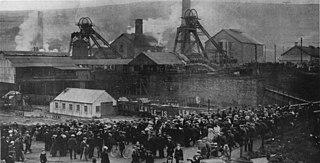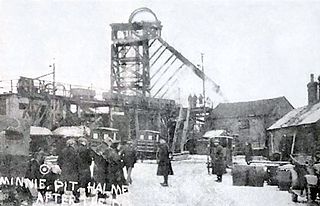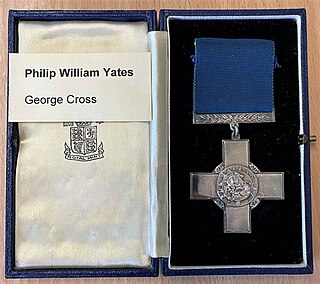Related Research Articles

The Davy lamp is a safety lamp used in flammable atmospheres, invented in 1815 by Sir Humphry Davy. It consists of a wick lamp with the flame enclosed inside a mesh screen. It was created for use in coal mines, to reduce the danger of explosions due to the presence of methane and other flammable gases, called firedamp or minedamp.
Firedamp is any flammable gas found in coal mines, typically coalbed methane. It is particularly found in areas where the coal is bituminous. The gas accumulates in pockets in the coal and adjacent strata and when they are penetrated the release can trigger explosions. Historically, if such a pocket was highly pressurized, it was termed a "bag of foulness".
A mining accident is an accident that occurs during the process of mining minerals or metals. Thousands of miners die from mining accidents each year, especially from underground coal mining, although accidents also occur in hard rock mining. Coal mining is considered much more hazardous than hard rock mining due to flat-lying rock strata, generally incompetent rock, the presence of methane gas, and coal dust. Most of the deaths these days occur in developing countries, and rural parts of developed countries where safety measures are not practiced as fully. A mining disaster is an incident where there are five or more fatalities.
Afterdamp is the toxic mixture of gases left in a mine following an explosion caused by methane-rich firedamp, which itself can initiate a much larger explosion of coal dust. The term is etymologically and practically related to other terms for underground mine gases—such as firedamp, white damp, and black damp, with afterdamp being composed, rather, primarily by carbon dioxide, carbon monoxide and nitrogen, with highly toxic stinkdamp-constituent hydrogen sulfide possibly also present. However, the high content of carbon monoxide is the component that kills, preferentially combining with haemoglobin in the blood and thus depriving victims of oxygen. Globally, afterdamp has caused many of the casualties in disasters of pit coalfields, including British, such as the Senghenydd colliery disaster. Such disasters continue to afflict working mines, for instance in mainland China.
A safety lamp is any of several types of lamp that provides illumination in places such as coal mines where the air may carry coal dust or a build-up of inflammable gases, which may explode if ignited, possibly by an electric spark. Until the development of effective electric lamps in the early 1900s, miners used flame lamps to provide illumination. Open flame lamps could ignite flammable gases which collected in mines, causing explosions; safety lamps were developed to enclose the flame to prevent it from igniting the explosive gases. Flame safety lamps have been replaced for lighting in mining with sealed explosion-proof electric lights, but continue to be used to detect gases.

The Senghenydd colliery disaster, also known as the Senghenydd explosion, occurred at the Universal Colliery in Senghenydd, near Caerphilly, Glamorgan, Wales, on 14 October 1913. The explosion, which killed 439 miners and a rescuer, is the worst mining accident in the United Kingdom. Universal Colliery, on the South Wales Coalfield, extracted steam coal, which was much in demand. Some of the region's coal seams contained high quantities of firedamp, a highly explosive gas consisting of methane and hydrogen.

The Oaks explosion, which happened at a coal mine in West Riding of Yorkshire on 12 December 1866, remains the worst mining disaster in England. A series of explosions caused by firedamp ripped through the underground workings at the Oaks Colliery at Hoyle Mill near Stairfoot in Barnsley killing 361 miners and rescuers. It was the worst mining disaster in the United Kingdom until the 1913 Senghenydd explosion in Wales.

The Gresford disaster occurred on 22 September 1934 at Gresford Colliery, near Wrexham, when an explosion and underground fire killed 261 men. Gresford is one of Britain's worst coal mining disasters: a controversial inquiry into the disaster did not conclusively identify a cause, though evidence suggested that failures in safety procedures and poor mine management were contributory factors. Further public controversy was caused by the decision to seal the colliery's damaged sections permanently, meaning that the bodies of only 8 of the miners were ever recovered. Two of the three rescue men who died were brought out leaving the third body in situ until recovery operations began the following year.
Events from the year 1894 in the United Kingdom.
Events from the year 1878 in the United Kingdom.

Barnburgh Main Colliery was a coal mine situated on the outskirts of the village of Barnburgh, about two miles north of Mexborough in the Dearne Valley, South Yorkshire, England. The sinking of the colliery was commenced in 1911 by the Manvers Main Colliery Company of Wath-upon-Dearne.
Events from the year 1872 in the United Kingdom.

Events from the year 1860 in the United Kingdom.

The Minnie Pit disaster was a coal mining accident that took place on 12 January 1918 in Halmer End, Staffordshire, in which 155 men and boys died. The disaster, which was caused by an explosion due to firedamp, is the worst ever recorded in the North Staffordshire Coalfield. An official investigation never established what caused the ignition of flammable gases in the pit.

Six Bells Colliery was a colliery located in Six Bells, Abertillery, Gwent, Wales. On 28 June 1960 it was the site of an underground explosion which killed 45 of the 48 miners working in that part of the mine. It is now the site of the artistically acclaimed Guardian memorial to those events, designed by Sebastian Boyesen; although the memorial primarily commemorates those who died at Six Bells, it is dedicated to all mining communities wherever they may be.

The Lancashire Coalfield in North West England was an important British coalfield. Its coal seams were formed from the vegetation of tropical swampy forests in the Carboniferous period over 300 million years ago.

The Bedford Colliery disaster occurred on Friday 13 August 1886 when an explosion of firedamp caused the death of 38 miners at Bedford No.2 Pit, at Bedford, Leigh in what then was Lancashire. The colliery, sunk in 1884 and known to be a "fiery pit", was owned by John Speakman.

Philip William Yates GC was an English recipient of the Edward Medal, later exchanged for a George Cross, awarded for gallantry in the 1931 Bentley Colliery Disaster in Yorkshire.
The Risca colliery disasters were a series of catastrophic mine explosions near the Welsh town of Risca in the nineteenth century. The most serious of these were in 1860 when more than 140 died in the Black Vein colliery and in 1880 when 120 died at the New Risca colliery.

Bentley Colliery was a coal mine in Bentley, near Doncaster in South Yorkshire, England, that operated between 1906 and 1993. In common with many other mines, it suffered disasters and accidents. The worst Bentley disaster was in 1931 when 45 miners were killed after a gas explosion. The site of the mine has been converted into a woodland.
References
- ↑ Weinreb, Ben; Hibbert, Christopher (1995). The London Encyclopaedia. Macmillan. ISBN 0-333-57688-8.
- ↑ "Leycett Colliery Explosion 1880". HealeyHero. Retrieved 18 October 2010.
- ↑ "Collieries at Leycett". Madeley, Staffordshire. Archived from the original on 11 June 2009. Retrieved 18 October 2010.
- ↑ Burke, James (1978). Connections . London: Macmillan. p. 242. ISBN 0-333-24827-9.
- 1 2 Williams, Hywel (2005). Cassell's Chronology of World History . London: Weidenfeld & Nicolson. pp. 433–434. ISBN 978-0-304-35730-7.
- 1 2 3 Palmer, Alan; Palmer, Veronica (1992). The Chronology of British History. London: Century Ltd. pp. 304–305. ISBN 978-0-7126-5616-0.
- ↑ "The Cathedral Story". Truro Cathedral. Archived from the original on 21 December 2004. Retrieved 5 June 2010.
- ↑ "New Risca Pit". Welsh Coal Mines. Retrieved 18 October 2010.
- ↑ "Gwents Time Line". Archived from the original on 15 June 2011. Retrieved 18 October 2010.
- ↑ Thompson, Ceri (2008). Harnessed: colliery horses in Wales. Cardiff: National Museum Wales. p. 46. ISBN 978-0-7200-0591-2.
- 1 2 Penguin Pocket On This Day. Penguin Reference Library. 2006. ISBN 978-0-14-102715-9.
- ↑ Berry, George (1970). Discovering Schools. Tring: Shire Publications. ISBN 978-0-85263-091-4.
- ↑ "Report". Durham Mining Museum. Retrieved 14 October 2010.
- ↑ "Wells lifeboat disaster". Sunderland Today. 2005. Archived from the original on 11 March 2007. Retrieved 21 October 2005.
- ↑ "Naval Colliery disasters". Welsh Coal Mines. Retrieved 14 October 2010.
- ↑ "English first performances". Ibsen.net. 12 May 2004. Retrieved 8 February 2013.
- ↑ "Festival of Nine Lessons and Carols". BBC. 16 December 2005. Retrieved 25 June 2010.
- ↑ "Scott's Porage – Our Heritage". Scott's Porage Oats. Archived from the original on 23 September 2010. Retrieved 19 October 2010.
- ↑ S. P. Rosenbaum, 'Strachey, (Giles) Lytton (1880–1932)’, Oxford Dictionary of National Biography, Oxford University Press, September 2004; online edn, May 2006
- ↑ "Charles Fuge Lowder". Project Canterbury. London: Catholic Literature Association. 1933. Retrieved 14 February 2021.